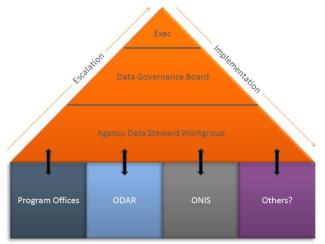Data Governance
A combination of policies, organizational roles and responsibilities, committee and team charters, and job descriptions that collectively describe how decisions are made, monitored and enforced regarding the collection, management, analysis and reporting of the organization’s data.
- Protecting Data Privacy.doc
- PARCC State Chiefs Assurance Letter.pdf
- Confidentiality Agreement.pdf
- Data Security Policy.pdf
- Data Access and Management Policy, Student Data.pdf
- Data Access and Management Policy, Certified Personnel Data.pdf
RIDE’s Data Governance structure reflects a three tiered model:
- Executive Committee
(Top Tier) - Data Governance Board
(Middle Tier) - Data Steward Work Group
(Largest Tier, with which Program Offices, ODAR, ONIS, and Other Stakeholders interact)
Escalation of issues, questions, and recommendations move up the model while implementations of data initiatives move down.

Data Governance Program includes:
The individuals, and the processes used, with responsibility for establishing and enforcing policies and guidance involving data
Rhode Island has implemented this Data Governance Program in recognition of the critical nature that data plays in the “business” of education.
Three Key Roles of the Data Governance Board are to:
- Prioritize education policy and research questions
- Determine new reporting needs and ideas
- Evaluate the requirements of adding new data elements to what is collected from schools and/or districts.
The Executive Committee’s mission is to:
provide direct oversight and leadership to the data governance structure.
While a low level of time commitment is required, a high level of personal engagement and organizational authority is required from this level.
The Executive Committee includes the senior RIDE executives (3 division chiefs and the Deputy Commissioner). It sets the overall mission and strategic goals of the data governance effort, as well as securing the funding, resources, and cooperation needed to support that effort.
The Executive Committee is the final decision-making authority on issues escalated beyond the Data Governance Board.
The Goals of the Data Governance Board are to:
- Ensure that the Statewide Longitudinal Data System (SLDS) is the primary source for informing data driven decision making processes.
- Achieve efficiency and consistency in collecting and reporting data across various Agency teams and source systems.
- Achieve high quality data in our collection, analysis, and reporting.
- Respond in a timely manner to data issues that are escalated to the DGB.
